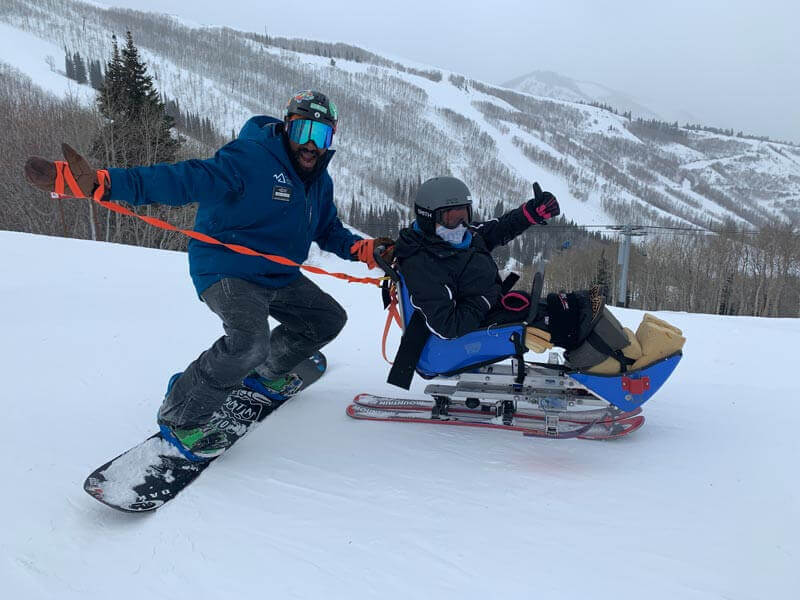A picture of Humpty Dumpty was placed on my bassinet when I was born. A sign to others that my bones break easily and to handle with caution. Being born with Osteogenesis Imperfecta (OI) means that my bones are fragile. In the past I have sneezed and broken my ribs, coughed and fractured my skull, and taken notes in class only to break my fingers.
As I got older, being cautious of everything never seemed to work well for me. I found myself getting involved in just about any non-contact sport I could. Three years ago, through an organization I participate in, I was given the opportunity to go on a ski trip to Utah with a few other girls. That was the first time I took a real chance on doing something that seemed very daring for a person with OI.
The National Ability Center is very experienced at helping people with disabilities ski; that became very clear to me when we arrived. I was taken aback by the different types of skis, spare parts, duct tape, and various sizes of foam used to add extra protection. I used a bi-ski equipped with lots of foam because of my short stature and OI. They also opted to have me use outriggers for safety, which is essentially used to keep the bi-ski from falling over to the sides. Once we were set up, we made our way to the ski lift.
This was my first time doing anything like this! My heart was racing and my adrenaline was flowing. I won't lie – the fear kicked in. "Maybe I made a mistake?" "Maybe I'm pushing my luck?" "What will happen if I break something so far from home?" These were just some of the thoughts that raced through my mind. I watched all the girls get set up, and slowly the room emptied out as they headed out to the slopes.
When we go out, we are with an instructor and a volunteer (a lot of this is possible because of volunteers!). At the lift, they stand on either side of you and help you into the lift, bi-ski and all. Then the bar comes down. You are also attached to the lift itself for extra safety. The view is sensational and the thought of being so high up on a mountain takes over. "Wow, I am about to start skiing!" I thought as the lift traveled the cable. I couldn't even imagine such a thing was possible, let along that I could do it, too. The instructor explains what will happen at the end of the lift, and as it approaches my heart starts pounding again. Once you reach the other end, it's basically the same idea. They wiggle you out and hoist you off the lift nice and smoothly.

Now the fun part begins! The instructor sets up his tethers, which are attached to the back of the bi-ski while the instructor holds on to the other end (imagine something similar to sled dogs pulling a sled). "Okay Jessica, when it's safe I will count to three and you'll be tethered," my instructor said. "One, two, three..." and he let me go. You can feel the release and an almost weightless feeling. The cold hitting you in the face even though you have a helmet, goggles, and neck gaiter on. The coldness of your fingertips is barely noticeable as you speed down the mountain.
The instructor shouts out your turns: "Left!" and you lean left, "Hard left!" and you lean further to the left. "Center!" and you come upright, and so on. For me, "Left!" was his first instruction, followed by small adjustments in my body moving the ski, then "Center!", "Hard right!" followed as I made my way down my first mountain. The feeling of going so fast is breathtaking, and the view of the Utah mountain range makes for a stunning added touch.
All of us girls were given the opportunity to experience adaptive skiing for five days and we loved every single moment. I never went beyond the blue slopes, but I dreamed of the feeling of being on a black diamond, which is for the most experienced skiers. Nevertheless I enjoyed every second, and never got hurt.
My cousin once told me, "You're going to break anyway, might as well break doing something cool instead of breaking because you flushed the toilet!" I took that to heart, and every day I am glad that I did. It keeps me cautious but fearless, daring but not foolish, and brittle but not broken.
About the Author
Jessica De La Rosa is a 36 year old college graduate, artist, dancer, former competitive rower, and Ms. Wheelchair New York 2016 title holder.
Her disability is called Osteogenesis Imperfecta, which means her bones can break with little or no cause. She was raised by her mother who also has an disability called Cerebral Palsy. Jessica was made very aware early in her childhood that their is no such thing as 'can't' and was always motivated and determined to get things done.
Today Jessica remains active in advocacy and has her own mentoring program which she started as MWNY. She wants everyone with disabilities to be advocates, learn their rights and live their lives as full as possible. They meet twice a month and have focused discussions, guest speakers, gives workshops to parents and go on trips among other things. She currently works for the Brooklyn Center for the Independence of the Disabled as their Systems Advocate.
Most of the stories here on LiveQuickie.com were submitted by readers. Do you have a story to tell? We'd love to hear it. Submit your story here.